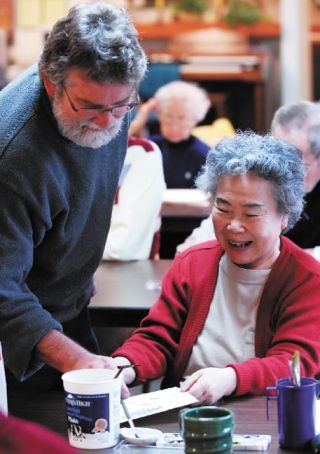Diversity and community make Ellsworth the richest address on Mercer Island
Editors note: This is the third and final story in a series on Mercer Island senior housing. The first, published on Jan. 10, detailed resources and starting points to turn to once a family has decided that it’s time to begin the search for a senior facility. The second, on Jan. 17, profiled the various options available on Mercer Island. In this installment, we focus on Ellsworth House, Mercer Island’s only low-income senior housing community.
By Cody Ellerd
Mercer Island Reporter
Just a few brush strokes, and suddenly the social room at Ellsworth House is awash with small, delicate goldfish swimming across 20 paper ponds.
It is Wednesday, which means painting day. Instructor Bruce Edwards demonstrates his “wet into wet” watercolor technique as the class imitates. Few students can understand his words, but few words are needed when teaching art.
All of the students are elderly. Most speak either Mandarin or another dialect of Chinese. When explanation is needed, 72-year-old Lee Feng, a resident and the keyholder of Ellsworth House, translates for the group.
“Very fun,” Feng says. Then, hearing a word he is less familiar with, he modifies his response. “Very cool.” His smile grows huge.
The weekly class is being held as part of Seniors Making Art, a nonprofit program established by Seattle glass artist Dale Chihuly that brings free painting, drawing, sculpture, collage and glass art lessons to places such as retirement homes, hospitals and senior centers. It is just one of the happenings that make Mercer Island’s only low-income senior residence unique and special, senior advocates and housing specialists say.
Edwards, who has been an instructor with Seniors Making Art since 1998 and teaches at several local retirement communities, says that at Ellsworth House, he always feels like a celebrity.
“I’ve gotten an incredibly big ego there because they all clap when I walk in the door,” he says. The students help him load materials from his car, pay rapt attention, are disarmingly polite and appreciative. “There’s a really big cultural difference between this group and the others.”
About 70 percent of Ellsworth’s 103 residents are Asian. Six are Russian, and two are East Indian. This is the one building on Mercer Island where Caucasians are the minority and everyone, at least in the eyes of the government, is poor.
The average annual income of a senior living at Ellsworth House is just over $8,000 per year, according to St. Andrew’s Housing Group, which owns and manages the property on 76th Ave. S.E. The average rent is about $200 per month — or 30 percent of the individual resident’s income. The rest of the cost to St. Andrew’s is subsidized by the Department of Housing and Urban Development (HUD).
Many of the residents have children living on Mercer Island, and that’s why they have come, either from within the area or from faraway countries like China or Korea, says manager Liz Gibson. That’s not an easy feat, especially considering that with a waiting list that currently stands at 11 years, Ellsworth House is the hardest senior living facility to get into on the Island. And the apartments are set up for independent living only, with no senior care or nursing services provided.
The fact that it has come to be mostly populated by Asian residents since its establishment in 1976 is largely a result of cultural values, says Jason Francis, Director of Fund Development for St. Andrew’s.
“You find that with Western residents, a lot of them stay isolated. They don’t need a group setting so much,” Francis says. But the strong desire for community typical of Asian cultures motivated the first residents of Ellsworth House to plan well, making sure that others got on the waiting list early. St. Andrew’s has been receptive to accommodating that desire elsewhere as well. At its Highland Gardens property in Issaquah, it created large family units to support a large Hmong population that needed affordable housing and wanted to live in a close-knit community with other Hmong families.
Gibson has made a big effort not only to make the foreign Ellsworth residents feel at home in the United States and on Mercer Island, but to make the American residents feel at home with them. Both English and Chinese classes are offered at the house on a weekly basis. Both are extremely popular.
“People are really trying to reach out to communicate with each other,” Gibson says. She often hears the Americans bellowing “Ni hao!,” “hello” in Chinese, as they greet their neighbors in the hall or elevator.
“Sometimes the words are done so badly the other people just look at them funny, but they try,” she says. “We’re all old so it’s very hard for all of us to learn new things — but everyone seems to be game.”
There is still a noticeable tendency, however, for residents to keep to their own. All 20 who signed up for the painting class are Asian, while at the weekly coffee social hour last Tuesday, most at the table, save for translator Lee Feng and one of the East Indian residents, were Caucasian. The group of friends assembled told stories about World War II, growing up in rural cabins and adventures of meeting classic film stars in Hollywood.
But as a Chinese resident entered the room and quietly took a seat in the corner of the room to work on her painting, talk turned toward the upcoming Chinese New Year celebration taking place at the house on the upcoming Friday. It has become an Ellsworth House tradition, with performances, socializing and potluck food that makes the coffee crowd start to salivate on the spot. They talk about the delicious dishes, and how nice it is to have the whole house out celebrating together.
Whether it’s for coffee hour or the New Year, resident Phyllis Presbrey says she feels a strong sense of community in the building.
“There’s a togetherness here,” she says. “It’s very nice.”



